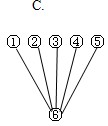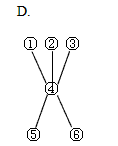阅读理解。
We like to keep our distance from others and there are very specific social rules about how close we can
go to others in particular situations. The social distances here are approximate, of course and will vary with
people. But they are still a good general rule. Hall identified four zones that are common for Americans:
Public Zone: >12 feet. The public zone is generally over 12 feet. That is, when we're walking around
town, we'll try to keep at least 12 feet between us and other people. Of course there're many times when we
cannot do this. We'll start to notice other people who are with in this distance. The closer they get, the more
we become aware.
Social Zone:4-12 feet. Within the social zone, we start to feel a connection with other people. When they're
closer, then we can talk with them without having to shout, but still keep them at a safe distance. This is a
comfortable distance for people who are standing in a group but maybe not talking directly with one another.
Personal Zone: 1.5-4feet. In the personal zone, the conversation gets more direct, and this is a good distance for two people who are talking seriously about something.
Intimate(亲密的)Zone: <1.5 feet. When a person is within arm's reach or closer, then we can touch them
in intimate ways. Romance of all kinds happens in this space. Entering intimate zone of somebody else can be
very threatening.
The rules about social distances vary with different groups of people. People who live in towns spend more
time close to one another. In a large and crowded city, the distances will be less than in a small town. Different
countries also have different rules about social distances. Watch a Japanese person talking at a party with a
person from a Western country. The Japanese will step in and the Westerner will step back. Speeded up, it's
like a dance around the room.
1. Which of the following shows how the text is organized? (①=Paragraph 1…)




2. In a less crowded place, an American usually keeps a stranger at a distance of _____ .
A. about 1.5 feet
B. less than 4 feet
C. about 2 feet
D. more than 12 feet
3. If eight people sit in a room and all of them don't talk directly with one another, they prefer _____.
A. Public Zone
B. Social Zone
C. Personal Zone
D. intimate Zone
4. What is the main idea of the last paragraph?
A. There're some rules about social distances
B. The Japanese are more polite than Americans
C. The rules about social distances can vary
D. Cities have fewer rules about social distances
5. What can we infer from the last paragraph?
A. The Japanese would like to dance with people from Western countries
B. The Westerner would like to keep close to people they are talking with at party
C. The Japanese would like to keep a distance from people they are talking with at party
D. The social distance between people in small towns is longer than that in large and crowded cities.




